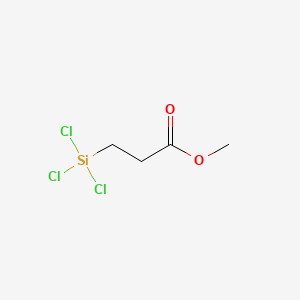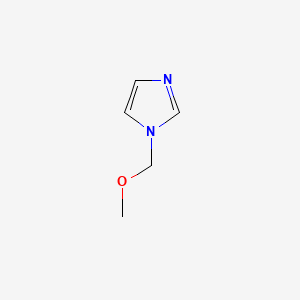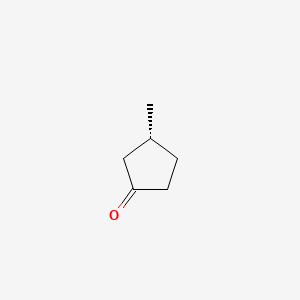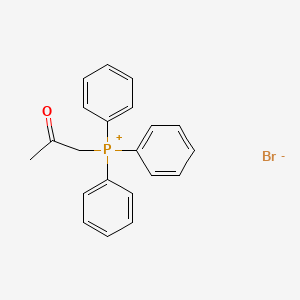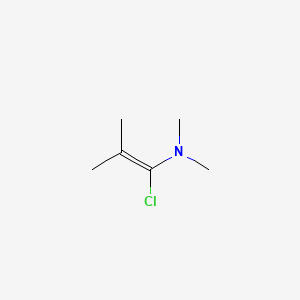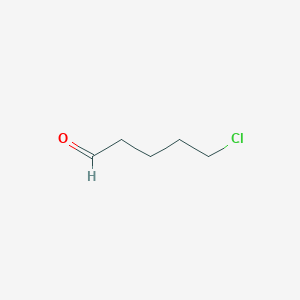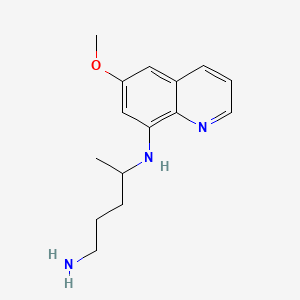
Primaquina
Descripción general
Descripción
La primaquina es un medicamento que se utiliza principalmente para tratar y prevenir la malaria, específicamente dirigida a las formas hepáticas latentes del parásito Plasmodium vivax y Plasmodium ovale . También se utiliza en combinación con otros medicamentos para tratar la neumonía por Pneumocystis . La this compound se sintetizó por primera vez en 1946 y está incluida en la Lista de Medicamentos Esenciales de la Organización Mundial de la Salud .
Mecanismo De Acción
El mecanismo exacto de acción de la primaquina no se comprende del todo. Se cree que interfiere con la producción de energía en el parásito de la malaria al atacar sus mitocondrias . Esta interrupción conduce a la generación de especies reactivas de oxígeno, que dañan los componentes celulares del parásito y, en última instancia, lo matan . La this compound también puede unirse y alterar las propiedades del ADN protozoario .
Aplicaciones Científicas De Investigación
La primaquina tiene una amplia gama de aplicaciones de investigación científica:
Análisis Bioquímico
Biochemical Properties
Primaquine interacts with various enzymes, proteins, and other biomolecules. It is metabolized in humans via three pathways . The first pathway involves direct glucuronide/glucose/carbamate/acetate conjugation of Primaquine. The second pathway involves hydroxylation (likely cytochrome P450-mediated) at different positions on the quinoline ring, with mono-, di-, or even tri-hydroxylations possible, and subsequent glucuronide conjugation of the hydroxylated metabolites . The third pathway involves the monoamine oxidase catalyzed oxidative deamination of Primaquine resulting in the formation of Primaquine-aldehyde, Primaquine alcohol, and carboxy Primaquine (cPQ), which are further metabolized through additional phase I hydroxylations and/or phase II glucuronide conjugations .
Cellular Effects
Primaquine has significant effects on various types of cells and cellular processes. It interferes with a part of the parasite (mitochondria) that is responsible for supplying it with energy . Without energy, the parasite dies, stopping the infection from continuing and allowing the person to recover .
Molecular Mechanism
It may be acting by generating reactive oxygen species or by interfering with the electron transport in the parasite . Primaquine may also bind to and alter the properties of protozoal DNA .
Temporal Effects in Laboratory Settings
In laboratory settings, the effects of Primaquine change over time. A single low-dose of Primaquine was found to be haematologically safe in a population of G6PD-normal and G6PD-deficient African males without malaria . The study observed haemoglobin levels up to 28 days after drug administration .
Dosage Effects in Animal Models
In animal models, the effects of Primaquine vary with different dosages . The plasma AUC 0-last (µg h/mL) (1.6 vs. 0.6), T 1/2 (h) (1.9 vs. 0.45), and T max (h) (1 vs. 0.5) were greater for S-Primaquine as compared to R-Primaquine .
Metabolic Pathways
Primaquine is involved in various metabolic pathways. As mentioned earlier, it is metabolized in humans via three pathways . These pathways involve various enzymes and cofactors, and can also affect metabolic flux or metabolite levels .
Transport and Distribution
Primaquine is transported and distributed within cells and tissues . The concentration of S-Primaquine was found to be higher in all tissues . At T max, (0.5–1 h in all tissues), the level of S-Primaquine was 3 times that of R-Primaquine in the liver .
Métodos De Preparación
Rutas sintéticas y condiciones de reacción
La primaquina se sintetiza mediante un proceso de varios pasos a partir de la 8-aminoquinolina. . Las condiciones de reacción suelen implicar el uso de bases fuertes y disolventes orgánicos para facilitar las reacciones de sustitución.
Métodos de producción industrial
La producción industrial de this compound implica la síntesis a gran escala utilizando condiciones de reacción similares a las de la síntesis de laboratorio, pero optimizadas para obtener mayores rendimientos y pureza. El proceso incluye pasos de purificación rigurosos para garantizar que el producto final cumple con los estándares farmacéuticos .
Análisis De Reacciones Químicas
Tipos de reacciones
La primaquina experimenta diversas reacciones químicas, que incluyen:
Sustitución: La this compound puede participar en reacciones de sustitución, especialmente en los grupos amino y metoxi.
Reactivos y condiciones comunes
Los reactivos comunes utilizados en las reacciones de la this compound incluyen agentes oxidantes como el peróxido de hidrógeno, agentes reductores como el borohidruro de sodio y varios disolventes orgánicos . Las reacciones se llevan a cabo normalmente bajo condiciones controladas de temperatura y pH para garantizar que se formen los productos deseados.
Productos principales formados
Los productos principales formados a partir de las reacciones de la this compound incluyen sus formas oxidadas y reducidas, así como varios derivados sustituidos . Estos productos se estudian a menudo por sus posibles actividades farmacológicas.
Comparación Con Compuestos Similares
La primaquina pertenece a la clase de compuestos de 8-aminoquinolina. Los compuestos similares incluyen:
Tafenoquina: Al igual que la this compound, la tafenoquina se utiliza para tratar y prevenir la malaria.
Cloroquina: Aunque no es una 8-aminoquinolina, la cloroquina es otro fármaco antimalárico que se dirige a las etapas sanguíneas del parásito.
La singularidad de la this compound radica en su capacidad para eliminar las formas hepáticas latentes de los parásitos de la malaria, lo que la hace esencial para prevenir las recaídas .
Propiedades
IUPAC Name |
4-N-(6-methoxyquinolin-8-yl)pentane-1,4-diamine | |
|---|---|---|
| Source | PubChem | |
| URL | https://pubchem.ncbi.nlm.nih.gov | |
| Description | Data deposited in or computed by PubChem | |
InChI |
InChI=1S/C15H21N3O/c1-11(5-3-7-16)18-14-10-13(19-2)9-12-6-4-8-17-15(12)14/h4,6,8-11,18H,3,5,7,16H2,1-2H3 | |
| Source | PubChem | |
| URL | https://pubchem.ncbi.nlm.nih.gov | |
| Description | Data deposited in or computed by PubChem | |
InChI Key |
INDBQLZJXZLFIT-UHFFFAOYSA-N | |
| Source | PubChem | |
| URL | https://pubchem.ncbi.nlm.nih.gov | |
| Description | Data deposited in or computed by PubChem | |
Canonical SMILES |
CC(CCCN)NC1=C2C(=CC(=C1)OC)C=CC=N2 | |
| Source | PubChem | |
| URL | https://pubchem.ncbi.nlm.nih.gov | |
| Description | Data deposited in or computed by PubChem | |
Molecular Formula |
C15H21N3O | |
| Source | PubChem | |
| URL | https://pubchem.ncbi.nlm.nih.gov | |
| Description | Data deposited in or computed by PubChem | |
Related CAS |
63-45-6 (1:2 PO4) | |
| Record name | Primaquine [INN:BAN] | |
| Source | ChemIDplus | |
| URL | https://pubchem.ncbi.nlm.nih.gov/substance/?source=chemidplus&sourceid=0000090346 | |
| Description | ChemIDplus is a free, web search system that provides access to the structure and nomenclature authority files used for the identification of chemical substances cited in National Library of Medicine (NLM) databases, including the TOXNET system. | |
DSSTOX Substance ID |
DTXSID8023509 | |
| Record name | Primaquine | |
| Source | EPA DSSTox | |
| URL | https://comptox.epa.gov/dashboard/DTXSID8023509 | |
| Description | DSSTox provides a high quality public chemistry resource for supporting improved predictive toxicology. | |
Molecular Weight |
259.35 g/mol | |
| Source | PubChem | |
| URL | https://pubchem.ncbi.nlm.nih.gov | |
| Description | Data deposited in or computed by PubChem | |
Physical Description |
Solid | |
| Record name | Primaquine | |
| Source | Human Metabolome Database (HMDB) | |
| URL | http://www.hmdb.ca/metabolites/HMDB0015219 | |
| Description | The Human Metabolome Database (HMDB) is a freely available electronic database containing detailed information about small molecule metabolites found in the human body. | |
| Explanation | HMDB is offered to the public as a freely available resource. Use and re-distribution of the data, in whole or in part, for commercial purposes requires explicit permission of the authors and explicit acknowledgment of the source material (HMDB) and the original publication (see the HMDB citing page). We ask that users who download significant portions of the database cite the HMDB paper in any resulting publications. | |
Boiling Point |
175-179 °C | |
| Record name | Primaquine | |
| Source | DrugBank | |
| URL | https://www.drugbank.ca/drugs/DB01087 | |
| Description | The DrugBank database is a unique bioinformatics and cheminformatics resource that combines detailed drug (i.e. chemical, pharmacological and pharmaceutical) data with comprehensive drug target (i.e. sequence, structure, and pathway) information. | |
| Explanation | Creative Common's Attribution-NonCommercial 4.0 International License (http://creativecommons.org/licenses/by-nc/4.0/legalcode) | |
| Record name | PRIMAQUINE | |
| Source | Hazardous Substances Data Bank (HSDB) | |
| URL | https://pubchem.ncbi.nlm.nih.gov/source/hsdb/6516 | |
| Description | The Hazardous Substances Data Bank (HSDB) is a toxicology database that focuses on the toxicology of potentially hazardous chemicals. It provides information on human exposure, industrial hygiene, emergency handling procedures, environmental fate, regulatory requirements, nanomaterials, and related areas. The information in HSDB has been assessed by a Scientific Review Panel. | |
Solubility |
5.64e-02 g/L | |
| Record name | Primaquine | |
| Source | Human Metabolome Database (HMDB) | |
| URL | http://www.hmdb.ca/metabolites/HMDB0015219 | |
| Description | The Human Metabolome Database (HMDB) is a freely available electronic database containing detailed information about small molecule metabolites found in the human body. | |
| Explanation | HMDB is offered to the public as a freely available resource. Use and re-distribution of the data, in whole or in part, for commercial purposes requires explicit permission of the authors and explicit acknowledgment of the source material (HMDB) and the original publication (see the HMDB citing page). We ask that users who download significant portions of the database cite the HMDB paper in any resulting publications. | |
Mechanism of Action |
Primaquine's mechanism of action is not well understood. It may be acting by generating reactive oxygen species or by interfering with the electron transport in the parasite. Also, although its mechanism of action is unclear, primaquine may bind to and alter the properties of protozoal DNA., The precise mechanism of action has not been determined, but may be based on primaquine's ability to bind to and alter the properties of DNA. Primaquine is highly active against the exoeryhrocytic stages of plasmodium vivax and plasmodium ovale and against the primary exoerythrocytic stages of plasmodium falciparum. It is also highly active against the sexual forms of (gametocytes) plasmodia, especially P. falciparum, disrupting transmission of the disease by eliminating the reservoir from which the mosquito carrier is infected., /Primaquine/ disrupts the parasitic mitochondria, thereby interrupting metabolic processes requiring energy., ... /Primaquine is one/ of /aromatic amine-containing/ xenobiotics ... capable to inducing oxidative injury in erythrocytes. These agents appear to potentiate the normal redox reactions and are capable of overwhelming the usual protective mechanisms. The interaction between these xenobiotics and hemoglobin leads to the formation of free radicals that denature critical proteins, including hemoglobin, thiol-dependent enzymes, and components of the erythrocyte membrane ... Oxidative denaturation of the globin chain decreases its affinity for the heme group, which may dissociate from the globin chain during oxidative injury ... The generation of free radicals may also lead to peroxidation of membrane lipids. This may affect the deformability of the erythrocyte and the permeability of the membrane to potassium. The alteration of the Na(+)/K(+) gradient is ... potentially lethal to the affected erythrocyte. Oxidative injury also impairs the metabolic machinery of the erythrocyte, resulting in a decrease in the concentration of ATP. Damage to the membrane can also permit leakage of denatured hemoglobin from the cell. Such free denatured hemoglobin can be toxic on its own. Free hemoglobin may irreversibly bind nitric oxide, resulting in vasoconstriction. Released hemoglobin may form nephrotoxic hemoglobin dimers, leading to kidney damage. /Oxidative hemolysis/ | |
| Record name | Primaquine | |
| Source | DrugBank | |
| URL | https://www.drugbank.ca/drugs/DB01087 | |
| Description | The DrugBank database is a unique bioinformatics and cheminformatics resource that combines detailed drug (i.e. chemical, pharmacological and pharmaceutical) data with comprehensive drug target (i.e. sequence, structure, and pathway) information. | |
| Explanation | Creative Common's Attribution-NonCommercial 4.0 International License (http://creativecommons.org/licenses/by-nc/4.0/legalcode) | |
| Record name | PRIMAQUINE | |
| Source | Hazardous Substances Data Bank (HSDB) | |
| URL | https://pubchem.ncbi.nlm.nih.gov/source/hsdb/6516 | |
| Description | The Hazardous Substances Data Bank (HSDB) is a toxicology database that focuses on the toxicology of potentially hazardous chemicals. It provides information on human exposure, industrial hygiene, emergency handling procedures, environmental fate, regulatory requirements, nanomaterials, and related areas. The information in HSDB has been assessed by a Scientific Review Panel. | |
Color/Form |
Viscous liquid | |
CAS No. |
90-34-6 | |
| Record name | Primaquine | |
| Source | CAS Common Chemistry | |
| URL | https://commonchemistry.cas.org/detail?cas_rn=90-34-6 | |
| Description | CAS Common Chemistry is an open community resource for accessing chemical information. Nearly 500,000 chemical substances from CAS REGISTRY cover areas of community interest, including common and frequently regulated chemicals, and those relevant to high school and undergraduate chemistry classes. This chemical information, curated by our expert scientists, is provided in alignment with our mission as a division of the American Chemical Society. | |
| Explanation | The data from CAS Common Chemistry is provided under a CC-BY-NC 4.0 license, unless otherwise stated. | |
| Record name | Primaquine [INN:BAN] | |
| Source | ChemIDplus | |
| URL | https://pubchem.ncbi.nlm.nih.gov/substance/?source=chemidplus&sourceid=0000090346 | |
| Description | ChemIDplus is a free, web search system that provides access to the structure and nomenclature authority files used for the identification of chemical substances cited in National Library of Medicine (NLM) databases, including the TOXNET system. | |
| Record name | Primaquine | |
| Source | DrugBank | |
| URL | https://www.drugbank.ca/drugs/DB01087 | |
| Description | The DrugBank database is a unique bioinformatics and cheminformatics resource that combines detailed drug (i.e. chemical, pharmacological and pharmaceutical) data with comprehensive drug target (i.e. sequence, structure, and pathway) information. | |
| Explanation | Creative Common's Attribution-NonCommercial 4.0 International License (http://creativecommons.org/licenses/by-nc/4.0/legalcode) | |
| Record name | PRIMAQUINE | |
| Source | DTP/NCI | |
| URL | https://dtp.cancer.gov/dtpstandard/servlet/dwindex?searchtype=NSC&outputformat=html&searchlist=27296 | |
| Description | The NCI Development Therapeutics Program (DTP) provides services and resources to the academic and private-sector research communities worldwide to facilitate the discovery and development of new cancer therapeutic agents. | |
| Explanation | Unless otherwise indicated, all text within NCI products is free of copyright and may be reused without our permission. Credit the National Cancer Institute as the source. | |
| Record name | Primaquine | |
| Source | EPA DSSTox | |
| URL | https://comptox.epa.gov/dashboard/DTXSID8023509 | |
| Description | DSSTox provides a high quality public chemistry resource for supporting improved predictive toxicology. | |
| Record name | Primaquine | |
| Source | European Chemicals Agency (ECHA) | |
| URL | https://echa.europa.eu/substance-information/-/substanceinfo/100.001.807 | |
| Description | The European Chemicals Agency (ECHA) is an agency of the European Union which is the driving force among regulatory authorities in implementing the EU's groundbreaking chemicals legislation for the benefit of human health and the environment as well as for innovation and competitiveness. | |
| Explanation | Use of the information, documents and data from the ECHA website is subject to the terms and conditions of this Legal Notice, and subject to other binding limitations provided for under applicable law, the information, documents and data made available on the ECHA website may be reproduced, distributed and/or used, totally or in part, for non-commercial purposes provided that ECHA is acknowledged as the source: "Source: European Chemicals Agency, http://echa.europa.eu/". Such acknowledgement must be included in each copy of the material. ECHA permits and encourages organisations and individuals to create links to the ECHA website under the following cumulative conditions: Links can only be made to webpages that provide a link to the Legal Notice page. | |
| Record name | PRIMAQUINE | |
| Source | FDA Global Substance Registration System (GSRS) | |
| URL | https://gsrs.ncats.nih.gov/ginas/app/beta/substances/MVR3634GX1 | |
| Description | The FDA Global Substance Registration System (GSRS) enables the efficient and accurate exchange of information on what substances are in regulated products. Instead of relying on names, which vary across regulatory domains, countries, and regions, the GSRS knowledge base makes it possible for substances to be defined by standardized, scientific descriptions. | |
| Explanation | Unless otherwise noted, the contents of the FDA website (www.fda.gov), both text and graphics, are not copyrighted. They are in the public domain and may be republished, reprinted and otherwise used freely by anyone without the need to obtain permission from FDA. Credit to the U.S. Food and Drug Administration as the source is appreciated but not required. | |
| Record name | PRIMAQUINE | |
| Source | Hazardous Substances Data Bank (HSDB) | |
| URL | https://pubchem.ncbi.nlm.nih.gov/source/hsdb/6516 | |
| Description | The Hazardous Substances Data Bank (HSDB) is a toxicology database that focuses on the toxicology of potentially hazardous chemicals. It provides information on human exposure, industrial hygiene, emergency handling procedures, environmental fate, regulatory requirements, nanomaterials, and related areas. The information in HSDB has been assessed by a Scientific Review Panel. | |
| Record name | Primaquine | |
| Source | Human Metabolome Database (HMDB) | |
| URL | http://www.hmdb.ca/metabolites/HMDB0015219 | |
| Description | The Human Metabolome Database (HMDB) is a freely available electronic database containing detailed information about small molecule metabolites found in the human body. | |
| Explanation | HMDB is offered to the public as a freely available resource. Use and re-distribution of the data, in whole or in part, for commercial purposes requires explicit permission of the authors and explicit acknowledgment of the source material (HMDB) and the original publication (see the HMDB citing page). We ask that users who download significant portions of the database cite the HMDB paper in any resulting publications. | |
Melting Point |
< 25 °C | |
| Record name | Primaquine | |
| Source | DrugBank | |
| URL | https://www.drugbank.ca/drugs/DB01087 | |
| Description | The DrugBank database is a unique bioinformatics and cheminformatics resource that combines detailed drug (i.e. chemical, pharmacological and pharmaceutical) data with comprehensive drug target (i.e. sequence, structure, and pathway) information. | |
| Explanation | Creative Common's Attribution-NonCommercial 4.0 International License (http://creativecommons.org/licenses/by-nc/4.0/legalcode) | |
| Record name | Primaquine | |
| Source | Human Metabolome Database (HMDB) | |
| URL | http://www.hmdb.ca/metabolites/HMDB0015219 | |
| Description | The Human Metabolome Database (HMDB) is a freely available electronic database containing detailed information about small molecule metabolites found in the human body. | |
| Explanation | HMDB is offered to the public as a freely available resource. Use and re-distribution of the data, in whole or in part, for commercial purposes requires explicit permission of the authors and explicit acknowledgment of the source material (HMDB) and the original publication (see the HMDB citing page). We ask that users who download significant portions of the database cite the HMDB paper in any resulting publications. | |
Synthesis routes and methods
Procedure details




Retrosynthesis Analysis
AI-Powered Synthesis Planning: Our tool employs the Template_relevance Pistachio, Template_relevance Bkms_metabolic, Template_relevance Pistachio_ringbreaker, Template_relevance Reaxys, Template_relevance Reaxys_biocatalysis model, leveraging a vast database of chemical reactions to predict feasible synthetic routes.
One-Step Synthesis Focus: Specifically designed for one-step synthesis, it provides concise and direct routes for your target compounds, streamlining the synthesis process.
Accurate Predictions: Utilizing the extensive PISTACHIO, BKMS_METABOLIC, PISTACHIO_RINGBREAKER, REAXYS, REAXYS_BIOCATALYSIS database, our tool offers high-accuracy predictions, reflecting the latest in chemical research and data.
Strategy Settings
| Precursor scoring | Relevance Heuristic |
|---|---|
| Min. plausibility | 0.01 |
| Model | Template_relevance |
| Template Set | Pistachio/Bkms_metabolic/Pistachio_ringbreaker/Reaxys/Reaxys_biocatalysis |
| Top-N result to add to graph | 6 |
Feasible Synthetic Routes
Q1: How does primaquine exert its antimalarial effects?
A1: While the exact mechanism of action remains incompletely understood, primaquine is known to target the liver stages of Plasmodium vivax and Plasmodium ovale malaria, specifically the dormant hypnozoites responsible for relapses. Primaquine's activity is believed to stem from its metabolites, which are thought to generate reactive oxygen species, leading to oxidative damage within the parasite. [, , ]
Q2: What is the role of primaquine metabolites in its antimalarial activity?
A2: Primaquine itself is a prodrug requiring bioactivation to exert its antimalarial effects. This bioactivation process involves enzymatic conversion, likely by cytochrome P450 enzymes, into active metabolites. [, ] One such metabolite, primaquine-5,6-orthoquinone (5,6-POQ), has been identified as a key mediator of primaquine's activity against Plasmodium parasites. []
Q3: Is primaquine effective against the blood stages of malaria parasites?
A3: Primaquine exhibits limited activity against the asexual blood stages of Plasmodium falciparum compared to its potent activity against liver-stage hypnozoites. [, , ]
Q4: What is the molecular formula and weight of primaquine?
A4: The molecular formula of primaquine is C15H21N3O, and its molecular weight is 259.34 g/mol.
Q5: How is primaquine metabolized in the body?
A5: Primaquine undergoes extensive metabolism in the liver, primarily via cytochrome P450 enzymes, particularly CYP2D6. This metabolism leads to the formation of various metabolites, some of which contribute to its antimalarial activity while others are associated with its toxicity. [, , ]
Q6: Does gender influence the pharmacokinetics of primaquine?
A6: Pharmacokinetic studies indicated comparable primaquine disposition between men and women, suggesting no need for dose adjustments based on sex. [, ]
Q7: How effective is primaquine in preventing relapses of Plasmodium vivax malaria?
A7: Primaquine is highly effective in preventing P. vivax relapses when administered at appropriate doses and durations. Clinical trials have demonstrated a significant reduction in relapse rates with higher total primaquine doses (≥5 mg/kg). []
Q8: Is there evidence of primaquine resistance?
A8: While widespread primaquine resistance has not been conclusively documented, several factors can impact treatment outcomes. These include variations in parasite susceptibility, host factors such as G6PD deficiency, and suboptimal adherence to prescribed primaquine regimens. [, , ]
Q9: What is the role of CYP2D6 polymorphisms in primaquine efficacy?
A9: CYP2D6 genetic variations, particularly those resulting in decreased enzyme activity, can significantly impact primaquine metabolism and reduce its efficacy. This highlights the importance of understanding the pharmacogenetics of primaquine for personalized treatment strategies. []
Q10: What are the major safety concerns associated with primaquine use?
A10: The primary concern is hemolytic anemia in individuals with G6PD deficiency. This enzyme is crucial for protecting red blood cells from oxidative damage, and its deficiency can lead to drug-induced hemolysis, particularly with primaquine and other 8-aminoquinolines. [, , , , ]
Q11: Are there strategies to improve primaquine delivery to its target sites?
A11: Researchers have explored nanoparticle formulations of primaquine to enhance its delivery to the liver, aiming to improve its efficacy against liver-stage parasites while potentially minimizing systemic exposure and associated toxicity. One study demonstrated that primaquine-loaded chitosan nanoparticles achieved a threefold increase in liver primaquine concentrations compared to conventional primaquine in rats. [, ]
Q12: What analytical methods are employed to quantify primaquine and its metabolites?
A12: Liquid chromatography coupled with mass spectrometry (LC-MS) is commonly utilized for the sensitive and specific quantification of primaquine and its metabolites in biological samples. This technique allows for the separation and detection of different chemical entities based on their mass-to-charge ratio, enabling comprehensive pharmacokinetic analyses. [, ]
Q13: How is the enantiomeric separation of primaquine and its metabolites achieved?
A13: Chiral chromatography, employing specialized stationary phases designed to separate enantiomers, is used to isolate and quantify individual enantiomers of primaquine and its metabolites. This technique is crucial for understanding potential differences in the pharmacological and toxicological profiles of individual enantiomers. []
Descargo de responsabilidad e información sobre productos de investigación in vitro
Tenga en cuenta que todos los artículos e información de productos presentados en BenchChem están destinados únicamente con fines informativos. Los productos disponibles para la compra en BenchChem están diseñados específicamente para estudios in vitro, que se realizan fuera de organismos vivos. Los estudios in vitro, derivados del término latino "in vidrio", involucran experimentos realizados en entornos de laboratorio controlados utilizando células o tejidos. Es importante tener en cuenta que estos productos no se clasifican como medicamentos y no han recibido la aprobación de la FDA para la prevención, tratamiento o cura de ninguna condición médica, dolencia o enfermedad. Debemos enfatizar que cualquier forma de introducción corporal de estos productos en humanos o animales está estrictamente prohibida por ley. Es esencial adherirse a estas pautas para garantizar el cumplimiento de los estándares legales y éticos en la investigación y experimentación.
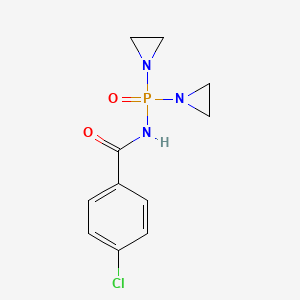

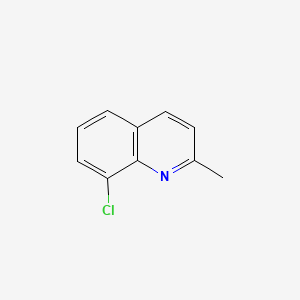



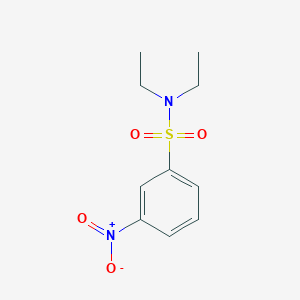
![2-Propanol, 1,1',1'',1'''-[[(2-hydroxypropyl)imino]bis(2,1-ethanediylnitrilo)]tetrakis-](/img/structure/B1584618.png)
